Navigating demands as a CISO or CIO means juggling multiple responsibilities – from mitigating cyber risks to managing personal liability. One of the biggest challenges is gaining the trust and understanding of the board. As cyber threats become more sophisticated, cybersecurity leaders must ensure that board members grasp the gravity of these risks and the strategic importance of robust security measures.
In this blog, we’ll explore actionable tips to help you effectively communicate your cybersecurity strategy to the board. We’ll focus on translating technical jargon into strategic insights, demonstrating the business impact of cybersecurity, and showcasing the critical role of the Security Operations Center (SOC). These strategies will not only enhance your board presentations but also solidify your position as a key player in the organization’s overall strategy and governance.
The first step in effective communication is understanding your audience. Board members focus on risk management, business continuity, and the bottom line. Tailor your presentation to address these priorities from the very beginning, translating technical jargon into business terms. Explain cybersecurity risks in the context of business impact, such as potential revenue loss, legal implications, and damage to the company’s reputation.
Data is a powerful tool to convey the urgency and importance of cybersecurity. However, presenting raw data and technical metrics might not resonate with all board members. Instead, use data to tell a story. Highlight trends in cyber threats, using industry benchmarks and case studies to provide context. Visual aids like graphs and charts can help illustrate points more effectively than text-heavy slides.
While it’s crucial to communicate the challenges and threats, it’s equally important to focus on solutions and strategies. Present a clear, actionable cybersecurity strategy that aligns with the organization’s business objectives. Include short- and long-term goals, budget requirements, and expected outcomes.
Establishing a culture of open communication with the board is essential. Encourage questions and engage in a dialogue to ensure board members feel informed and involved in the cybersecurity strategy. Offer regular updates, not just in times of crisis, to maintain transparency and build trust.
Cybersecurity is an evolving field, and continuous improvement is key. Solicit feedback from the board on the information and presentation style. Stay informed about new threats, technologies, and best practices to ensure your strategy remains relevant and effective.
For CISOs to be board-ready, they must effectively communicate the importance of cybersecurity in terms of business impact, use data to support their strategy, focus on solutions, foster open communication, and commit to continuous improvement. By following these guidelines, CISOs can ensure that cybersecurity remains a top priority at the board level, safeguarding the organization’s assets, reputation, and future.
To ensure you’re getting the most out of your cybersecurity program, request a free consultation with our team.

Call us directly and we’ll put you in touch with the most relevant cyber expert.
Not currently free to call? Give us a brief description of what you’re looking for by filling out our form and we’ll email you as soon as we can.
